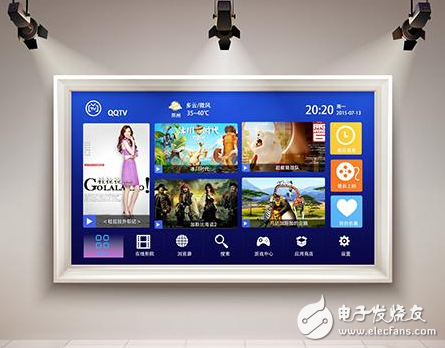Smart TVs have become the third most popular digital products in consumer households. The ownership rates of wearable digital products and smart home products have reached 34% and 26% respectively... The above conclusions and figures are from the "Digital Trends" published by Mintel 2017" (hereinafter referred to as the "report"), this report is based on a survey of consumers from Tier 1 to Tier 3 cities in China.

Smart TV becomes the third largest digital product
For a long time, the top 5 digital products with the highest consumer ownership rate are smartphones, laptops, desktop computers, digital cameras/camcorders, and tablets. But these five digital products have encountered development bottlenecks. In recent years, with the exception of tablet computers, the ownership rates of these types of products have continued to decline. Figures from Mintel show that between 2013 and 2017, Chinese urban consumers’ home ownership of smartphones dropped by 6%, laptop computers by 15%, desktop computers by 19%, and digital/camcorders by 28%. .
Regarding the decline in smartphone ownership, Mintel senior analyst Ma Zichun said in an interview with a reporter from China Business Daily that compared with mature countries such as the United Kingdom and the United States, China’s smartphone ownership rate may have been falsely high before, mainly due to some consumption. Previously, it was impossible to distinguish the difference between "feature phone" and "smart phone". The decline in smartphone ownership (as claimed by consumers) reflects the growing awareness and knowledge of digital products among consumers.
Mintel believes that the actual ownership rate of smart phones in Chinese households is on the rise, and some third-tier (or even lower-tier) cities will see faster growth rates in the future.
The decline in laptop ownership is due to the prevalence of the “cross-category†concept. With the increasing popularity of tablets and smart phones that are more portable and more functional, consumers are focusing on home laptops, desktop computers and digital cameras/ After the camera "retires", such products will no longer be purchased. At the same time, more and more consumers realize the importance of offline contact with people, and are eager to participate more in offline entertainment activities. Therefore, fewer and fewer consumers will continue to buy notebook/desktop computers because of their strong office performance.
Compared with these categories, the ownership rate of smart TVs has been rising. In 2017, it surpassed desktop computers, digital cameras/camcorders and tablets, becoming the third most popular digital products in consumer households. According to Mintel, based on the perception of “smart TVs†of interviewed consumers, 68% of households (declared) have smart TVs in 2017, an increase of 12% over the previous year.
According to data from the Ministry of Industry and Information Technology, in the first half of 2017, my country’s color TV output was 74.23 million units, a year-on-year decrease of 6.4%. Among them, LCD TVs had 69.62 million units, a year-on-year decrease of 8.5%; smart TVs were 47.11 million units, a year-on-year increase. 0.2%, accounting for 63.5% of color output.
Mintel believes that "smart TVs" are rapidly spreading in China's first to third-tier cities, mainly because the prices of smart TVs tend to be more rational and civilian. However, Mintel added that this does not represent the household ownership rate of smart TVs in China. Taking into account that some consumers are still unclear about the concept of "smart phones", and some consumers have unclear understanding of "smart TVs", this has led to a relatively high number of ownership rates.
At the same time, video and service subscriptions are a major part of the development of smart TV. As more and more people spend more time experiencing online life, consumers will find unlimited subscription services more cost-effective. The report shows that 38% of respondents have subscribed to online video services, 31% have not subscribed but expressed interest in purchasing such services; 20% of respondents have subscribed to online music services, and 38% have not subscribed but expressed interest Purchase such services; 43% of respondents subscribed to online game services, and 22% did not subscribe but expressed interest in purchasing such services.
"The price-performance ratio is an important factor in choosing a brand, so unlimited (subscription) services will have more room for development. Brands allow consumers to pay a fixed fee and get an unlimited number of products or services; this not only allows consumers to make the most effective use of The purchased products or services can better control their consumer behavior; it can also change consumer behavior, and brands with outstanding performance can establish closer connections with consumers and obtain higher levels of user loyalty." Ma Zi Chun said.

Complementary development of wearable and smart home
The report shows that the ownership rate of wearable digital products and smart home products has increased significantly. Chinese urban consumers have 34% of wearable digital products and 26% of smart home products. In 2016, the ownership rates of these two types of products were respectively These are 15% and 8%. At the same time, wearable digital products and smart home products rank among the top three digital products (44% and 42%, respectively) that are more frequently used by consumers (compared to 3 months ago).
In Ma Zichun's view, these emerging digital products are not a competitive relationship, but complementary advantages to help consumers create an intelligent, automated, and controllable lifestyle anytime, anywhere. According to the report, 49% of users of wearable digital products own smart home products (while the average proportion is 26%); among users of smart home products, 64% have wearable digital products (while the average proportion is 34%).
In fact, with the increase in market share in recent years, the growth rate of fitness trackers and smart watches will inevitably slow down compared with previous years; With the maturity of networking, the market share of wearable digital products and smart home products will continue to grow in a complementary manner.
One of the major factors driving the development of smart homes is safety. The report shows that 74% of respondents are concerned about security-related functions, including “receive security alerts when not at homeâ€, “monitor the condition of family members or petsâ€, and “can lock or unlock doors wherever they are†Wait. "Monitor the status of family members or pets" (60%) and "Receive security alerts when not at home" (56%) are the top 2 smart home features that most appeal to the new middle class.
At the same time, Mintel believes that the fundamental motivation for consumers to purchase smart home products is to gain a sense of control. For example, for parents, tracking their children’s location to ensure their personal safety and protecting children from negative online media content ( Such as violence and pornographic information) etc.
Insulated Power Cable,Bimetallic Crimp Lugs Cable,Pvc Copper Cable,Cable With Copper Tube Terminal
Taixing Longyi Terminals Co.,Ltd. , https://www.lycopperterminals.com